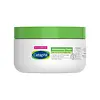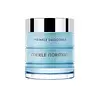What's inside
What's inside
 Key Ingredients
Key Ingredients

 Benefits
Benefits

 Concerns
Concerns

 Ingredients Side-by-side
Ingredients Side-by-side

Water
Skin ConditioningHydrogenated Polydecene
EmollientCaprylic/Capric Triglyceride
MaskingDimethicone
EmollientGlycerin
HumectantButylene Glycol
HumectantCetearyl Olivate
Sorbitan Olivate
EmulsifyingCyclopentasiloxane
EmollientMarrubium Vulgare Extract
Skin ConditioningHydrolyzed Hyaluronic Acid
HumectantOlea Europaea Fruit Oil
MaskingTocopheryl Acetate
AntioxidantAscorbyl Palmitate
AntioxidantLeuconostoc/Radish Root Ferment Filtrate
AntimicrobialPhospholipids
Skin ConditioningIsopropyl Lauroyl Sarcosinate
Skin ConditioningCetearyl Alcohol
EmollientSodium Polyacrylate
Absorbent1,2-Hexanediol
Skin ConditioningCaprylyl Glycol
EmollientPolymethylsilsesquioxane
Isohexadecane
EmollientGlyceryl Stearate
EmollientPEG-100 Stearate
Cetearyl Methicone
Skin ConditioningPhenoxyethanol
PreservativePEG-40 Stearate
EmulsifyingSteareth-2
EmulsifyingSteareth-21
CleansingRetinyl Palmitate
Skin ConditioningLinoleic Acid
CleansingLycopene
AntioxidantWater, Hydrogenated Polydecene, Caprylic/Capric Triglyceride, Dimethicone, Glycerin, Butylene Glycol, Cetearyl Olivate, Sorbitan Olivate, Cyclopentasiloxane, Marrubium Vulgare Extract, Hydrolyzed Hyaluronic Acid, Olea Europaea Fruit Oil, Tocopheryl Acetate, Ascorbyl Palmitate, Leuconostoc/Radish Root Ferment Filtrate, Phospholipids, Isopropyl Lauroyl Sarcosinate, Cetearyl Alcohol, Sodium Polyacrylate, 1,2-Hexanediol, Caprylyl Glycol, Polymethylsilsesquioxane, Isohexadecane, Glyceryl Stearate, PEG-100 Stearate, Cetearyl Methicone, Phenoxyethanol, PEG-40 Stearate, Steareth-2, Steareth-21, Retinyl Palmitate, Linoleic Acid, Lycopene
Water
Skin ConditioningCyclopentasiloxane
EmollientIsodecyl Neopentanoate
EmollientHydrogenated Polyisobutene
EmollientGlycerin
HumectantButylene Glycol
HumectantIsohexadecane
EmollientStearic Acid
CleansingCetyl Alcohol
EmollientNylon-12
Glyceryl Stearate
EmollientStearyl Alcohol
EmollientDimethicone
EmollientGlyceryl Polymethacrylate
Acetyl Hexapeptide-8
HumectantPalmitoyl Tripeptide-1
Skin ConditioningSerine
MaskingGlycine
BufferingProline
Skin ConditioningPalmitoyl Carnitine
Skin ConditioningAlanine
MaskingGlutamic Acid
HumectantCamellia Sinensis Leaf Extract
AntimicrobialCalluna Vulgaris Flower Extract
Skin ConditioningCentella Asiatica Extract
CleansingRetinyl Palmitate
Skin ConditioningTocopheryl Acetate
AntioxidantAscorbyl Palmitate
AntioxidantPCA
HumectantPhospholipids
Skin ConditioningChamomilla Recutita Flower Extract
MaskingEchinacea Purpurea Extract
MoisturisingPEG-20 Stearate
EmulsifyingPEG-100 Stearate
Dimethicone Crosspolymer
Emulsion StabilisingBisabolol
MaskingAcrylates/C10-30 Alkyl Acrylate Crosspolymer
Emulsion StabilisingXanthan Gum
EmulsifyingEthoxydiglycol
HumectantLecithin
EmollientGlucose
HumectantLactic Acid
BufferingTriethanolamine
BufferingPropylene Glycol
HumectantDisodium EDTA
Phenoxyethanol
PreservativeDiazolidinyl Urea
PreservativeWater, Cyclopentasiloxane, Isodecyl Neopentanoate, Hydrogenated Polyisobutene, Glycerin, Butylene Glycol, Isohexadecane, Stearic Acid, Cetyl Alcohol, Nylon-12, Glyceryl Stearate, Stearyl Alcohol, Dimethicone, Glyceryl Polymethacrylate, Acetyl Hexapeptide-8, Palmitoyl Tripeptide-1, Serine, Glycine, Proline, Palmitoyl Carnitine, Alanine, Glutamic Acid, Camellia Sinensis Leaf Extract, Calluna Vulgaris Flower Extract, Centella Asiatica Extract, Retinyl Palmitate, Tocopheryl Acetate, Ascorbyl Palmitate, PCA, Phospholipids, Chamomilla Recutita Flower Extract, Echinacea Purpurea Extract, PEG-20 Stearate, PEG-100 Stearate, Dimethicone Crosspolymer, Bisabolol, Acrylates/C10-30 Alkyl Acrylate Crosspolymer, Xanthan Gum, Ethoxydiglycol, Lecithin, Glucose, Lactic Acid, Triethanolamine, Propylene Glycol, Disodium EDTA, Phenoxyethanol, Diazolidinyl Urea
Ingredients Explained
These ingredients are found in both products.
Ingredients higher up in an ingredient list are typically present in a larger amount.
Ascorbyl Palmitate is created by combining pure Vitamin C and palmitic acid. It is an antioxidant and helps reduce hyperpigmentation.
This ingredient is a more stable version of Vitamin C, meaning it does not disintegrate as quickly when exposed to sunlight. However, studies show it does not penetrate skin as well as pure Vitamin C.
Ascorbyl Palmitate is oil soluble.
Read more about other types of Vitamin C:
Learn more about Ascorbyl PalmitateButylene Glycol (or BG) is used within cosmetic products for a few different reasons:
Overall, Butylene Glycol is a safe and well-rounded ingredient that works well with other ingredients.
Though this ingredient works well with most skin types, some people with sensitive skin may experience a reaction such as allergic rashes, closed comedones, or itchiness.
Learn more about Butylene GlycolCyclopentasiloxane, or D5, is a silicone used to improve texture of products and trap moisture.
D5 is considered lightweight and volatile. Volatile means it evaporates quickly after application. Once evaporated, D5 leaves a thin barrier that helps keep skin hydrated.
It is also an emollient. Emollients help soften the skin and prevent water loss. Silicones create a silky texture in products. D5 helps other ingredients become more spreadable.
Studies show D5 is safe to use in skincare products. We recommend speaking with a skincare professional if you have concerns.
Learn more about CyclopentasiloxaneDimethicone is a type of synthetic silicone created from natural materials such as quartz.
What it does:
Dimethicone comes in different viscosities:
Depending on the viscosity, dimethicone has different properties.
Ingredients lists don't always show which type is used, so we recommend reaching out to the brand if you have questions about the viscosity.
This ingredient is unlikely to cause irritation because it does not get absorbed into skin. However, people with silicone allergies should be careful about using this ingredient.
Note: Dimethicone may contribute to pilling. This is because it is not oil or water soluble, so pilling may occur when layered with products. When mixed with heavy oils in a formula, the outcome is also quite greasy.
Learn more about DimethiconeGlycerin is already naturally found in your skin. It helps moisturize and protect your skin.
A study from 2016 found glycerin to be more effective as a humectant than AHAs and hyaluronic acid.
As a humectant, it helps the skin stay hydrated by pulling moisture to your skin. The low molecular weight of glycerin allows it to pull moisture into the deeper layers of your skin.
Hydrated skin improves your skin barrier; Your skin barrier helps protect against irritants and bacteria.
Glycerin has also been found to have antimicrobial and antiviral properties. Due to these properties, glycerin is often used in wound and burn treatments.
In cosmetics, glycerin is usually derived from plants such as soybean or palm. However, it can also be sourced from animals, such as tallow or animal fat.
This ingredient is organic, colorless, odorless, and non-toxic.
Glycerin is the name for this ingredient in American English. British English uses Glycerol/Glycerine.
Learn more about GlycerinGlyceryl Stearate is a mix of glycerin and stearic acid.
It is used to stabilize the mixing of water and oil ingredients. By preventing these ingredients from separating, it can help elongate shelf life. It can also help thicken the product's texture.
As an emollient, it helps soften skin and supports barrier-replenishing ingredients.
In cosmetics, Glyceryl Stearate is often made from vegetable oils or synthetically produced.
This ingredient may not be fungal-acne safe
Fun fact: The human body also creates Glyceryl Stearate naturally.
Learn more about Glyceryl StearateIsohexadecane is added to enhance texture, emulsify, and to help cleanse. It is an isoparrafin. It is a component of petrolatum.
Due to its large size, Isohexadecane is not absorbed by the skin. Instead, it sits on top and acts as an emollient. Emollients help keep your skin soft and smooth by trapping moisture within.
Isohexadecane is often used in products designed to help oily skin. It is lightweight and non-greasy while helping to moisturize. When mixed with silicones, it gives a product a silky feel.
Learn more about IsohexadecanePeg-100 Stearate is an emollient and emulsifier. As an emollient, it helps keep skin soft by trapping moisture in. On the other hand, emulsifiers help prevent oil and water from separating in a product.
PEGS are a hydrophilic polyether compound . There are 100 ethylene oxide monomers in Peg-100 Stearate. Peg-100 Stearate is polyethylene glycol ester of stearic acid.
Phenoxyethanol is a preservative that has germicide, antimicrobial, and aromatic properties. Studies show that phenoxyethanol can prevent microbial growth. By itself, it has a scent that is similar to that of a rose.
It's often used in formulations along with Caprylyl Glycol to preserve the shelf life of products.
Phospholipids are naturally found in our skin as they are the main component of cell membranes. Phospholipids have humectant, emollient, antioxidant properties.
Phospholipids are complex lipids that contain glycerin, two fatty acids, and a phosphate group. Some foods that contain phospholipids include soybeans and milk. The phospholipids found in soy come from Lecithin. This ingredient can also be synthetically created.
Due to their hygroscopic nature, they act as both humectants and emollients. Humectants draw moisture from the air to your skin, while emollients help trap moisture in.
The phospholipids in our skin can be naturally depleted. Replenishing the phospholipids in our skin can help hydrate your skin.
Studies show phospholipids display antioxidant activity and may help with reducing the signs of aging.
This ingredient is non-occlusive.
Some types of phospholipids:
Learn more about PhospholipidsRetinyl palmitate is a form of retinoid. Retinoids are the superstar class of anti-aging ingredients that include tretinoin and retinol.
This particular ingredient has had a bumpy year with its rise and fall in popularity.
First, Retinyl palmitate is created from palmitic acid and retinol. It is a retinol ester and considered one of the weaker forms of retinoid.
This is because all retinoids have to be converted to Tretinoin, AKA retinoic acid. Retinyl Palmitate is pretty far down the line and has to go through multiple conversions before its effects are seen.
Due to this long and ineffective conversion line, the benefits of Retinyl Palmitate are debated.
Studies show Retinyl Palmitate to help:
Dermatologists say this ingredient is ineffective because it isn't used in high enough concentrations in cosmetics.
This ingredient used to be found in sunscreens to boost the efficacy of sunscreen filters.
The downfall of Retinyl Palmitate was due to released reports about the ingredient being correlated to sun damage and skin tumors.
While there is a study showing this ingredient to cause DNA damage when exposed to UV-A, there is no concrete proof of it being linked to skin cancer. It is safe to use when used correctly.
All retinoids increase your skin's sensitivity to the sun in the first few months of usage. Be especially careful with reapplying sunscreen when using any form of retinoid.
Currently, this ingredient is still allowed in cosmetics all over the world. In Canada, cosmetics must have a warning label stating the product to contain Retinyl Palmitate
Fun fact: This ingredient is often added to low-fat milk to increase the levels of Vitamin A.
Learn more about Retinyl PalmitateTocopheryl Acetate is AKA Vitamin E. It is an antioxidant and protects your skin from free radicals. Free radicals damage the skin by breaking down collagen.
One study found using Tocopheryl Acetate with Vitamin C decreased the number of sunburned cells.
Tocopheryl Acetate is commonly found in both skincare and dietary supplements.
Learn more about Tocopheryl AcetateWater. It's the most common cosmetic ingredient of all. You'll usually see it at the top of ingredient lists, meaning that it makes up the largest part of the product.
So why is it so popular? Water most often acts as a solvent - this means that it helps dissolve other ingredients into the formulation.
You'll also recognize water as that liquid we all need to stay alive. If you see this, drink a glass of water. Stay hydrated!
Learn more about Water